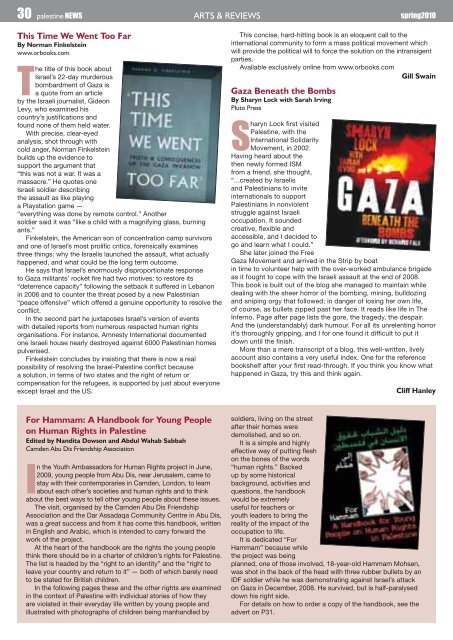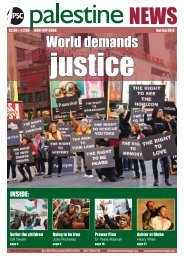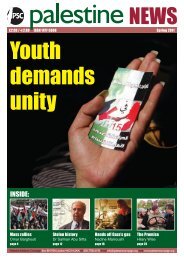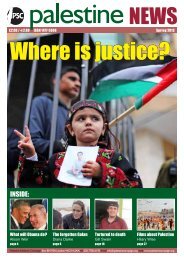INSIDE: - Palestine Solidarity Campaign
INSIDE: - Palestine Solidarity Campaign
INSIDE: - Palestine Solidarity Campaign
You also want an ePaper? Increase the reach of your titles
YUMPU automatically turns print PDFs into web optimized ePapers that Google loves.
30 palestine NEWS<br />
ARTS & REVIEWS<br />
spring2010<br />
This Time We Went Too Far<br />
By Norman Finkelstein<br />
www.orbooks.com<br />
The title of this book about<br />
Israel’s 22-day murderous<br />
bombardment of Gaza is<br />
a quote from an article<br />
by the Israeli journalist, Gideon<br />
Levy, who examined his<br />
country’s justifications and<br />
found none of them held water.<br />
With precise, clear-eyed<br />
analysis, shot through with<br />
cold anger, Norman Finkelstein<br />
builds up the evidence to<br />
support the argument that<br />
“this was not a war. It was a<br />
massacre.” He quotes one<br />
Israeli soldier describing<br />
the assault as like playing<br />
a Playstation game —<br />
“everything was done by remote control.” Another<br />
soldier said it was “like a child with a magnifying glass, burning<br />
ants.”<br />
Finkelstein, the American son of concentration camp survivors<br />
and one of Israel’s most prolific critics, forensically examines<br />
three things: why the Israelis launched the assault, what actually<br />
happened, and what could be the long term outcome.<br />
He says that Israel’s enormously disproportionate response<br />
to Gaza militants’ rocket fire had two motives: to restore its<br />
“deterrence capacity” following the setback it suffered in Lebanon<br />
in 2006 and to counter the threat posed by a new Palestinian<br />
“peace offensive” which offered a genuine opportunity to resolve the<br />
conflict.<br />
In the second part he juxtaposes Israel’s version of events<br />
with detailed reports from numerous respected human rights<br />
organisations. For instance, Amnesty International documented<br />
one Israeli house nearly destroyed against 6000 Palestinian homes<br />
pulverised.<br />
Finkelstein concludes by insisting that there is now a real<br />
possibility of resolving the Israel-<strong>Palestine</strong> conflict because<br />
a solution, in terms of two states and the right of return or<br />
compensation for the refugees, is supported by just about everyone<br />
except Israel and the US.<br />
This concise, hard-hitting book is an eloquent call to the<br />
international community to form a mass political movement which<br />
will provide the political will to force the solution on the intransigent<br />
parties.<br />
Available exclusively online from www.orbooks.com<br />
Gill Swain<br />
Gaza Beneath the Bombs<br />
By Sharyn Lock with Sarah Irving<br />
Pluto Press<br />
Sharyn Lock first visited<br />
<strong>Palestine</strong>, with the<br />
International <strong>Solidarity</strong><br />
Movement, in 2002.<br />
Having heard about the<br />
then newly formed ISM<br />
from a friend, she thought,<br />
“...created by Israelis<br />
and Palestinians to invite<br />
internationals to support<br />
Palestinians in nonviolent<br />
struggle against Israeli<br />
occupation. It sounded<br />
creative, flexible and<br />
accessible, and I decided to<br />
go and learn what I could.”<br />
She later joined the Free<br />
Gaza Movement and arrived in the Strip by boat<br />
in time to volunteer help with the over-worked ambulance brigade<br />
as it fought to cope with the Israeli assault at the end of 2008.<br />
This book is built out of the blog she managed to maintain while<br />
dealing with the sheer horror of the bombing, mining, bulldozing<br />
and sniping orgy that followed; in danger of losing her own life,<br />
of course, as bullets zipped past her face. It reads like life in The<br />
Inferno. Page after page lists the gore, the tragedy, the despair.<br />
And the (understandably) dark humour. For all its unrelenting horror<br />
it’s thoroughly gripping, and I for one found it difficult to put it<br />
down until the finish.<br />
More than a mere transcript of a blog, this well-written, lively<br />
account also contains a very useful index. One for the reference<br />
bookshelf after your first read-through. If you think you know what<br />
happened in Gaza, try this and think again.<br />
Cliff Hanley<br />
For Hammam: A Handbook for Young People<br />
on Human Rights in <strong>Palestine</strong><br />
Edited by Nandita Dowson and Abdul Wahab Sabbah<br />
Camden Abu Dis Friendship Association<br />
In the Youth Ambassadors for Human Rights project in June,<br />
2009, young people from Abu Dis, near Jerusalem, came to<br />
stay with their contemporaries in Camden, London, to learn<br />
about each other’s societies and human rights and to think<br />
about the best ways to tell other young people about these issues.<br />
The visit, organised by the Camden Abu Dis Friendship<br />
Association and the Dar Assadaqa Community Centre in Abu Dis,<br />
was a great success and from it has come this handbook, written<br />
in English and Arabic, which is intended to carry forward the<br />
work of the project.<br />
At the heart of the handbook are the rights the young people<br />
think there should be in a charter of children’s rights for <strong>Palestine</strong>.<br />
The list is headed by the “right to an identity” and the “right to<br />
leave your country and return to it” — both of which barely need<br />
to be stated for British children.<br />
In the following pages these and the other rights are examined<br />
in the context of <strong>Palestine</strong> with individual stories of how they<br />
are violated in their everyday life written by young people and<br />
illustrated with photographs of children being manhandled by<br />
soldiers, living on the street<br />
after their homes were<br />
demolished, and so on.<br />
It is a simple and highly<br />
effective way of putting flesh<br />
on the bones of the words<br />
“human rights.” Backed<br />
up by some historical<br />
background, activities and<br />
questions, the handbook<br />
would be extremely<br />
useful for teachers or<br />
youth leaders to bring the<br />
reality of the impact of the<br />
occupation to life.<br />
It is dedicated “For<br />
Hammam” because while<br />
the project was being<br />
planned, one of those involved, 18-year-old Hammam Mohsen,<br />
was shot in the back of the head with three rubber bullets by an<br />
IDF soldier while he was demonstrating against Israel’s attack<br />
on Gaza in December, 2008. He survived, but is half-paralysed<br />
down his right side.<br />
For details on how to order a copy of the handbook, see the<br />
advert on P31.







